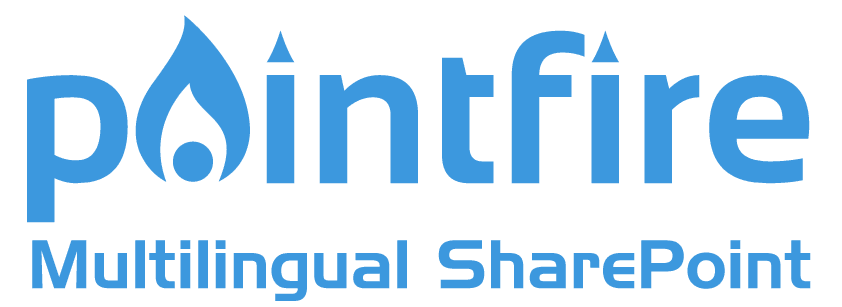This series of posts is based on my talk about Language & MUI in SharePoint 2016 & O365
Different components of the Office 365 suite have different ways of setting language. Even within a single page, different parts of a page can be in different languages because they are government by different settings. In this post we will talk mostly about how the user’s language is set for the purpose of MUI in SharePoint 2013 and 2016 and in SharePoint Online and other SharePoint-like components like OneDrive for Business.
Alternate languages
Every SharePoint site and Sharepoint-like site has one site language and zero or more alternate languages. In a normal site, or in OneDrive go to the gear menu -> Site Settings -> Language settings (under Site Administration). Sometimes it is not in the menu, so instead edit the URL to add “_layouts/15/muisetng.aspx”. For Group sites, those created by the Group feature, you don’t need to do anything, the sites are created with every language already selected.
In on-premise, the list of potential Alternate languages is determined by the SharePoint language packs that you have installed on the server farm, but in Office 365, all language packs are already pre-installed.
Select the list of languages that you want to be available for MUI on this site. In another post, we will see how to select the languages using PowerShell.
What sets the user’s MUI language
When alternate languages have been selected for a site, it is possible for different users to see many elements of the user interface in different languages. The language choice applies to that user only.
There are three major settings that determine the user’s MUI language once the alternate languages have been selected: the browser settings, the User Profile display language settings, and the Office 365 Account language setting.
Browser language settings
Your browser language settings are the lowest-priority setting, and will work for most of SharePoint only when the other two settings do not have a valid value. I won’t go into the details of how to set your browser’s language preference, but it’s a ranked list. Your browser communicates to the SharePoint server what is its first, second, third choice, etc. The first one that matches the site or alternate languages for the site is the one that gets selected.
Note that the list of languages that you can select in your browser doesn’t match the list of languages that SharePoint supports. The browser lets you select a general language like English (en) or a more specific one like Australian English (en-AU), while SharePoint only supports American English (en-US). Don’t worry about it, SharePoint does a pretty good job of matching that language to the language it supports. For languages where SharePoint supports different versions, like Portuguese or Serbian, it will choose the version that you specify if both are available or the one that the site supports if the site only supports one.
Although it’s not the best way to select your language, there are several reasons why you might use the browser settings. Certain other Office 365 components only support browser settings. There is at least one component of SharePoint, having to do with the caching of Managed Metadata, that only works properly when the browser setting is set, and it can be used for the “Instant Toggle Trick” that we will see below.
User Profile language setting
In both SharePoint on premise and SharePoint Online, the user can have a user profile where their language preference is stored. Navigating to a screen that lets you edit this settings may differ depending on how user profiles are managed in your case, but here is the most common location.
Click your name or picture at the top of a SharePoint screen, then select About me. In SharePoint on premise it will bring you to you’re my site, in Office 365 it will bring you to Delve. Click “About me” then click “Edit profile”
In SharePoint on premise, on the Edit Details page, you will see “Basic Information”, “Contact Information”, “Details”, “…”. Click on the ellipsis (three dots) then click Language and Region.
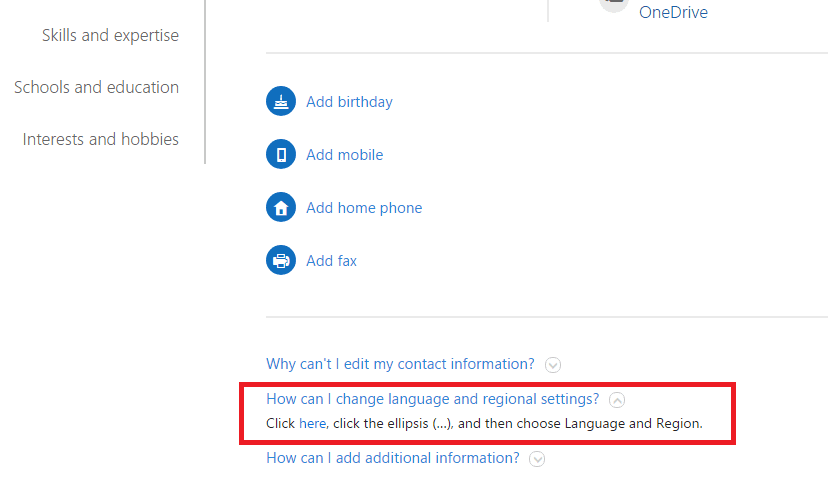
In Office 365, getting to that page is different. A little further down the Edit Profile page, you will see the text “How can I change the regional and language settings?” Click on it and it will show the line “Click here, click the ellipsis (...), and then select Language and Region.” Follow those instructions. Under “Language” in the section “Language Preferences” you will see “My Display Languages”. You can change the order of the languages that are there or pick a new language from the list and click on “Add”. [Note: it can get a little trickier; this assumes that you are using the default UserSettingsProvider. That’s for another day.]
For some reason, the list of languages that it offers includes a lot of languages that SharePoint doesn’t even support, like Lower Sorbian and Mohawk. Pick one or more languages that you want, rank them in the order you want, then click “Save all and close”. It will show you a message saying “Your changes have been saved, but they may take some time to take effect. Don't worry if you don't see them right away.” It usually takes a few minutes for them to take effect, but sometimes it can be hours. On some sites like Delve itself the effect is quick, but on others it can take several minutes or longer.
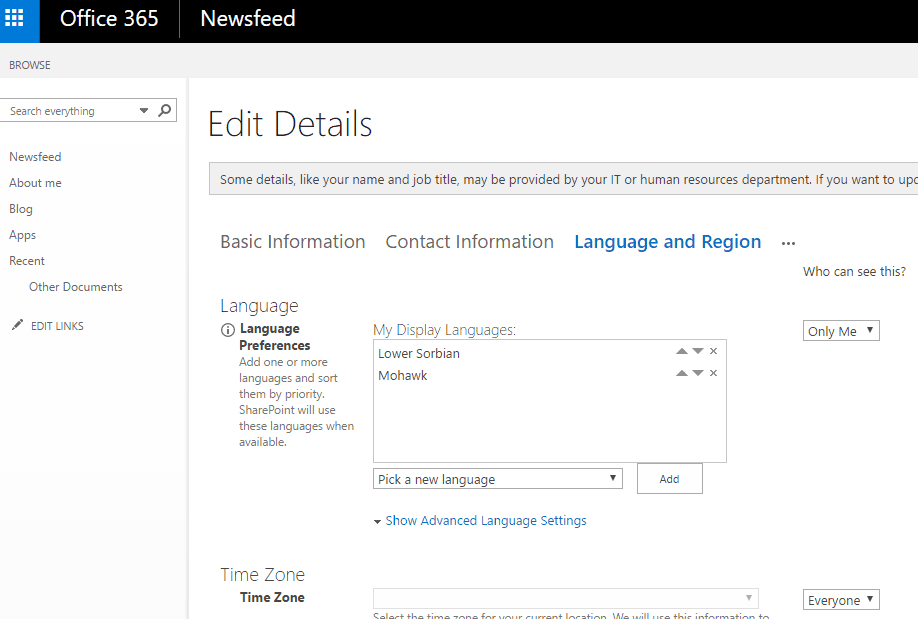
On SharePoint sites that have alternate languages, the first language in the User Profile's language list that matches one of the site languages is the one that gets selected and only when none of them match does it look at the browser settings.
Office 365 Account language setting
Office 365 has an account language setting distinct from the Profile language setting. As opposed to the other settings it has a single value, it is not a ranked list. To get to it, click the gear icon, then Office 365 settings. It is at the bottom of the screen.
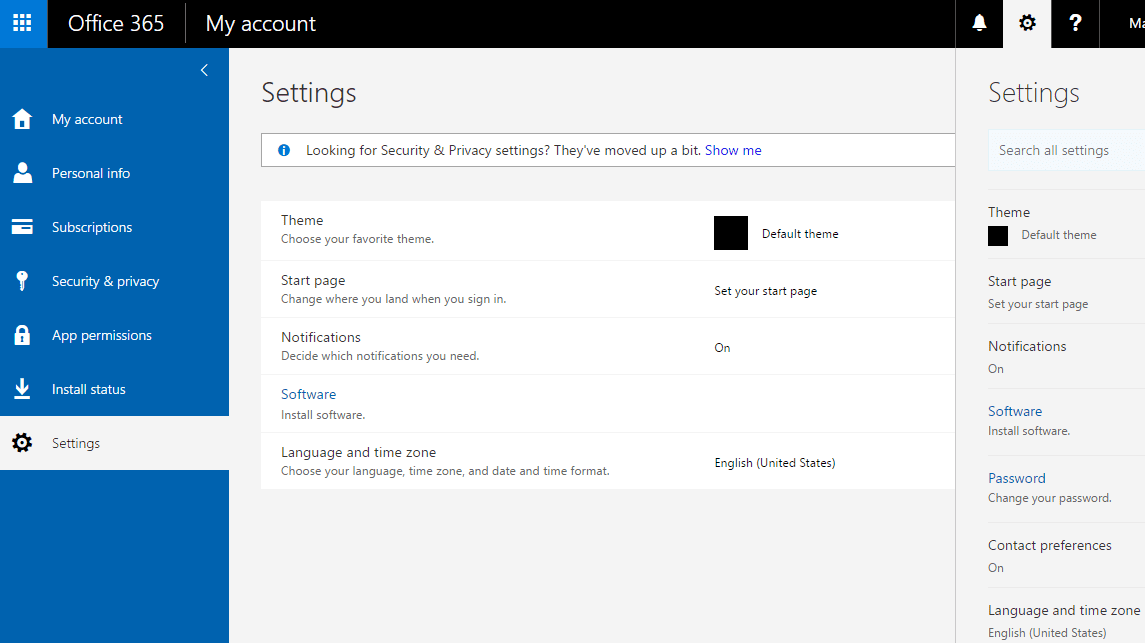
When you click on the language, you get yet another different list of languages to choose from, as well as other regional settings.
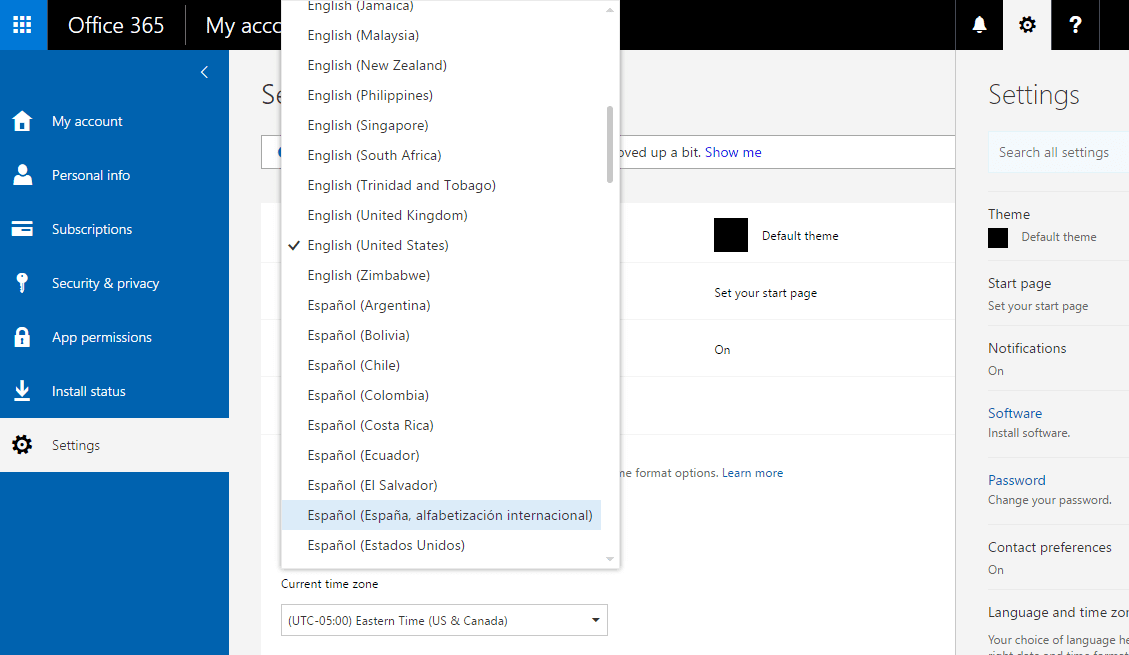
Two different things happen when you change that language. First, there are direct effects on the components of Office 365 whose language is controlled by the Office 365 Account language setting. These are mostly non-SharePoint components, but it includes the name of Office 365 components. Second, there are indirect effects. When you change your account settings it will automatically change the list of languages in your Profile to the one language that is in your new Account setting. That in turn will eventually affect SharePoint and other Office 365 components.
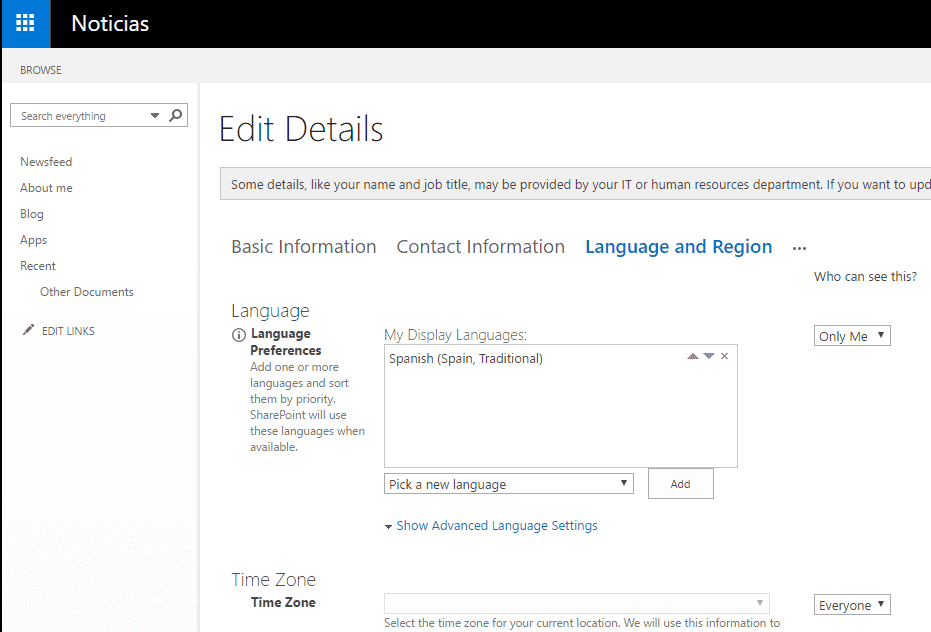
You can go back to the Profile and see that the Lower Sorbian and Mohawk have been replaced with the language that you just chose. This will eventually have an effect on all your SharePoint sites. You can change the setting back to whatever you want, but some advice: wait for an hour or so. If you change your language setting again too quickly, bad things can happen. Bad things like the setting won’t match what’s displayed and might not change at all until you change both settings again, respecting the proper long ritual pauses between changes.
The Instant Toggle Trick
The problem with changing your language setting using either the Profile or the Account setting is all the waiting involved. If you’re a developer or content author and you need to change language regularly, how can you do it quickly? The answer is the Instant Toggle Trick™.
1. Use an Account language setting that has no overlap with your site’s base + alt languages
2. Make your Profile language setting blank, or one that has no overlap with base + alt languages
3. Go home, come back tomorrow
4. Now change browser language settings. The language change will be instantaneous
